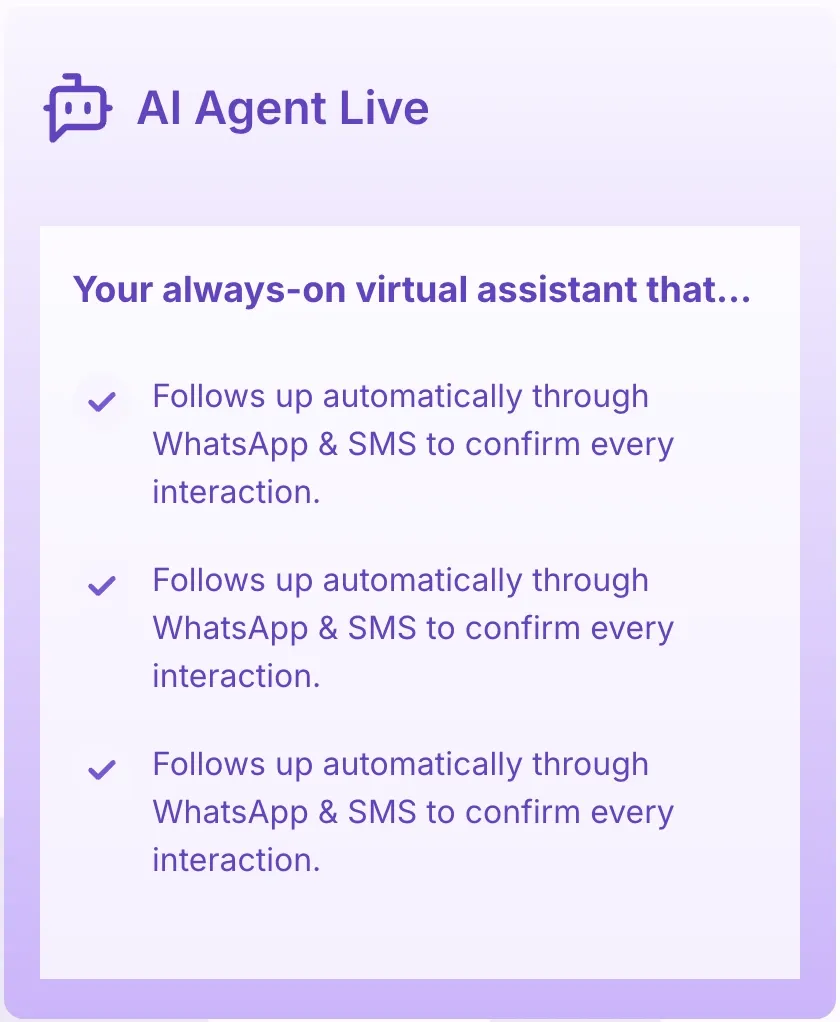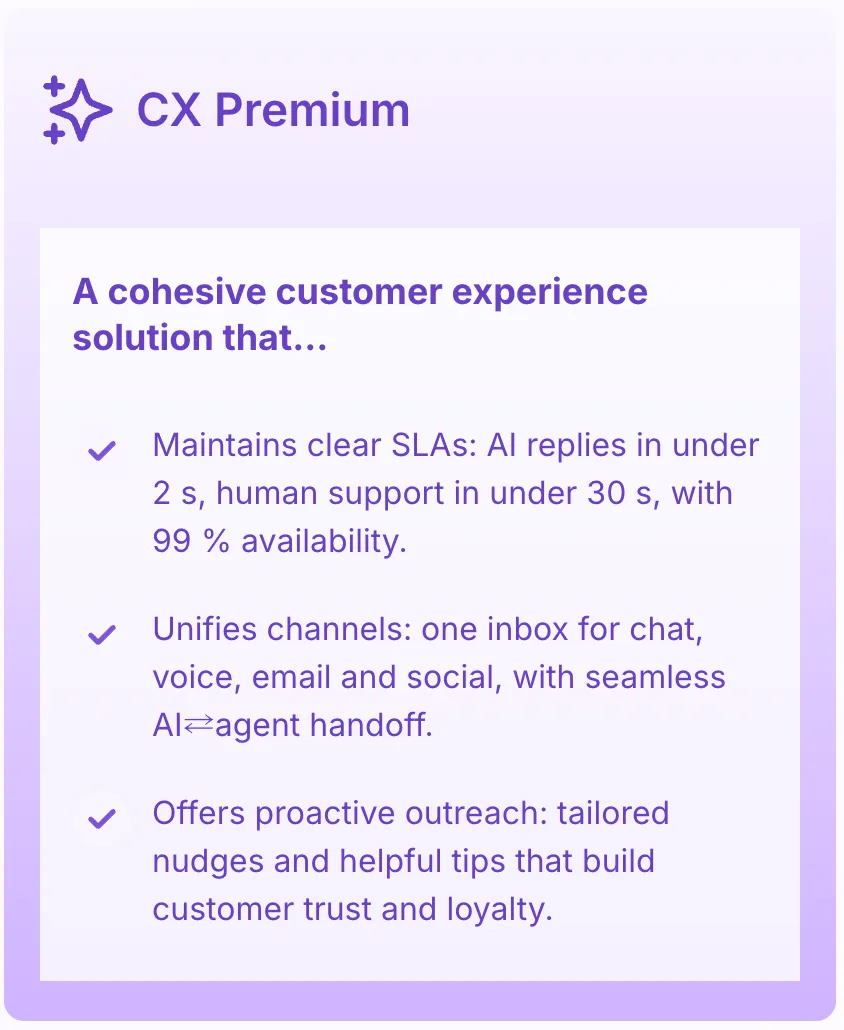To address this issue, businesses are turning to unified automation platforms. These innovative solutions integrate AI-powered technology to manage customer interactions on over 35 channels simultaneously, reshaping the way companies provide support services.
The impact of these platforms on customer service operations is remarkable:
- Instant response capabilities across multiple channels
- Seamless integration of voice and text communications
- AI-driven automation for routine inquiries
- Personalized customer interactions at scale
- Significant reduction in operational costs
Now, your customer support team can deliver consistent, high-quality service regardless of how or where your customers choose to contact you. This technological advancement not only streamlines operations but also transforms the entire customer service landscape by empowering businesses to engage with customers on their preferred platforms.
The Power of Multi-Channel Communication in Customer Support
Modern customers expect seamless interactions across multiple platforms. Multi-channel communication has transformed from a luxury to a necessity in customer support, with businesses needing to meet customers where they are - whether that's WhatsApp, Instagram, or traditional email.
Key Communication Channels:
- Text-based platforms
- WhatsApp Business
- Facebook Messenger
- Instagram Direct Messages
- Twitter DMs
- Live chat widgets
- Voice-based solutions
- Traditional phone calls
- VoIP services
- Voice messages
- Video calls
- Email systems
- Corporate email
- Support ticketing
- Newsletter communications
The digital landscape demands presence across these diverse channels. Unified automation platforms integrate these communication streams into a single interface, enabling support teams to manage conversations efficiently without switching between multiple applications.
Impact on Customer Engagement:
- Reduced response times through instant channel accessibility
- Enhanced customer satisfaction with preferred communication methods
- Improved conversation tracking across multiple touchpoints
- Seamless context switching between channels
- Consistent brand voice across all platforms
This multi-channel approach creates a robust support ecosystem where customers can initiate conversations through their preferred platform while support teams maintain full context of previous interactions. The result is a more engaging, personalized customer experience that drives loyalty and satisfaction.
Transforming Customer Service with AI-Powered Automation
AI-powered automation is changing the game for customer service. It takes traditional support systems and turns them into super-efficient operations that can handle thousands of inquiries at once. With modern AI technology, customer queries are processed and answered in the blink of an eye, providing instant solutions across various channels.
How AI-Powered Automation Works
The intelligent automation engine specializes in several key areas:
- Rapid Query Resolution: AI algorithms quickly analyze customer messages, understand their intent, and provide accurate responses within seconds.
- Smart Routing: Complex queries are automatically classified and directed to specialized human agents who can handle them.
- 24/7 Availability: Customers can reach out for support anytime, without any delays or waiting times.
- Consistent Responses: All customer interactions receive standardized solutions, ensuring a uniform experience.
The Role of Email Automation in Unified Platforms
Advanced email automation features play a crucial role in unified customer service platforms:
- Incoming emails are automatically categorized based on their content.
- Urgent requests are given priority and handled promptly.
- Common inquiries receive automated responses generated by the system.
- Follow-up actions are scheduled intelligently to ensure no customer query goes unanswered.
- Attachments and documents sent via email are processed efficiently.
The Impact of AI-Powered Automation
These platforms have achieved impressive results:
- Response times have been reduced by 80%.
- Manual handling of emails has decreased by 75%.
- Query classification accuracy stands at an impressive 90%.
- First-contact resolution rates have improved by 60%.
Continuous Learning for Better Customer Service
The AI engine behind these systems is constantly learning from every interaction it has with customers. This means that over time, its ability to understand and respond accurately improves, adapting to new customer needs as they arise. This self-learning capability ensures that the system remains up-to-date with changing demands in customer service while consistently delivering high levels of satisfaction.
Enhancing Customer Experience with Intelligent Automation
Conversation continuity is crucial in today's customer support. With unified automation platforms, businesses can track and maintain context across various channels, creating a seamless experience for each customer. For example, when a customer switches from email to WhatsApp, the AI remembers previous conversations, eliminating the need for repetitive explanations.
Transforming Conversations with Hyper-Personalization
Hyper-personalization takes standard responses and turns them into meaningful conversations using:
- Real-time analysis of customer history
- Recognition of purchase patterns
- Integration of behavioral data
- Understanding of individual preferences
The AI uses this information to generate responses that resonate with each customer, creating genuine, personalized interactions on a large scale.
Breaking Language Barriers with Multilingual Support
Intelligent automation also offers multilingual support capabilities, breaking down language barriers across 135+ languages and regional dialects. This flexibility allows businesses to:
- Serve diverse global markets
- Connect with local communities
- Build trust through communication in native languages
- Reduce misunderstandings in cross-cultural interactions
The impact of intelligent automation goes beyond simple translation - it captures cultural subtleties and local expressions while maintaining brand voice consistency across languages. Companies that have implemented multilingual support have reported up to a 60% increase in customer satisfaction scores, demonstrating the direct link between language accessibility and brand loyalty.
These automated systems adapt tone and style based on cultural context, ensuring that communications feel natural and culturally appropriate for each market segment. The AI's ability to switch between languages while keeping conversation context intact creates seamless experiences for customers all over the world.

Using Advanced AI Technologies for Better Customer Interactions
What is Multi-LLM Architecture?
Multi-LLM architectures are a major breakthrough in automating customer support. These advanced systems use multiple Large Language Models (LLMs), each specializing in different aspects of communication, to provide more nuanced and context-aware responses.
Key Parts of Multi-LLM Architecture:
- Primary Language Model - This model handles the main understanding and generating responses.
- Specialized Models - These models focus on specific tasks like figuring out what the customer wants.
- Integration Layer - This layer coordinates how the models work together to produce cohesive outputs.
The true strength of Multi-LLM systems is their ability to understand complex customer queries from various perspectives. When a customer sends a message, it goes through multiple specialized models, each offering its own insights to create a complete understanding.
How Does Multi-LLM Work?
Here's how the Multi-LLM architecture works:
- A customer sends a message or query.
- The Primary Language Model analyzes the message and generates an initial response.
- The Specialized Models (such as intent recognition or sentiment analysis) process the message simultaneously, extracting specific information.
- The Integration Layer combines the outputs from all models, ensuring they align and make sense together.
- Finally, the system delivers a comprehensive response that considers both the content and emotional context of the customer's message.
Benefits of Multi-LLM Architecture
The Multi-LLM architecture offers several advantages over traditional single-model approaches:
- Enhanced Understanding: By involving multiple models with different expertise, the system can grasp complex queries better than a single model could.
- Contextual Awareness: Each specialized model brings its own context to the table, leading to more accurate interpretations and responses.
- Flexibility: New specialized models can be added easily without disrupting existing ones, allowing continuous improvement based on evolving business needs.
These benefits make Multi-LLM architectures an ideal solution for businesses looking to automate their customer support while maintaining high-quality interactions.
Real-World Applications of Multi-LLM Architecture
The power of Multi-LLM architecture extends beyond just understanding customer queries. Here are some real-world applications where this technology can make a significant impact:
- Crisis Management: Detecting urgent issues that require immediate attention by analyzing both intent and sentiment signals.
- Sales Opportunities: Identifying positive sentiment patterns during conversations for potential upselling opportunities.
- Customer Retention: Early detection of dissatisfaction signals through combined analysis of intent and tone.
- Brand Voice Consistency: Ensuring consistent tone across all interactions by integrating brand guidelines into specialized models.
With these applications, businesses can proactively address critical situations, drive revenue growth through targeted sales efforts, retain unhappy customers before it's too late, and maintain a cohesive brand image across various channels.
Conclusion
Multi-LLM architectures represent a significant advancement in automating customer support by leveraging multiple specialized models working together seamlessly. This approach enables deeper understanding of complex queries while also considering emotional nuances—ultimately leading to more meaningful conversations between brands and their customers.

Ensuring Seamless Integration and Scalability with Unified Automation Platforms
Unified automation platforms excel at integrating with your existing tech stack through pre-built connectors and APIs. You can connect these platforms to your current tools within minutes, not weeks or months. This plug-and-play approach means your customer service operations continue running smoothly during implementation.
Key Integration Benefits:
- Zero disruption to existing workflows
- Minimal training requirements for your team
- Instant access to automation capabilities
- Native compatibility with popular business tools
The built-in CRM support transforms how you manage customer relationships. These platforms automatically create detailed customer profiles by collecting data across all interaction points. Your support team gains instant access to:
- Complete conversation history
- Purchase records
- Previous support tickets
- Customer preferences
- Interaction patterns
The automated transcript upload feature streamlines data management by:
- Converting voice calls to searchable text
- Categorizing conversations by topic
- Identifying common customer issues
- Generating actionable insights
- Creating detailed interaction logs
This seamless data flow enables you to scale your support operations efficiently. The platforms handle increasing customer volumes while maintaining consistent service quality across all channels. Your team can focus on complex customer needs while automation handles routine queries and data management tasks.
Driving Operational Efficiency Through Intelligent Workflows and Cost Optimization Strategies
AI-driven workflows transform customer support operations by automating repetitive tasks and streamlining complex processes. Support teams using unified automation platforms report 51% reduction in operational costs through intelligent workflow optimization.
Key efficiency improvements include:
- Smart Ticket Routing: AI algorithms analyze incoming queries and automatically direct them to appropriate agents based on expertise, workload, and priority
- Automated Categorization: Machine learning systems tag and classify support tickets instantly, eliminating manual sorting
- Predictive Issue Resolution: AI identifies patterns in customer inquiries to suggest solutions before problems escalate
- Resource Allocation: Real-time analytics optimize agent scheduling and workload distribution
These automated workflows deliver measurable productivity gains:
- 80% reduction in ticket processing time
- 3x increase in first-contact resolution rates
- 65% decrease in average handling time
- 40% improvement in agent productivity
Cost optimization strategies through automation include:
- Intelligent Queue Management: Prioritizes high-value customer interactions
- Automated Response Systems: Handles routine inquiries without human intervention
- Peak Load Management: Scales support capacity automatically during high-demand periods
- Performance Analytics: Identifies bottlenecks and optimization opportunities in real-time
Support teams implementing these AI-driven workflows report handling 4x more customer interactions while maintaining consistent service quality across all communication channels.

Achieving Tangible Business Results with Unified Automation Platforms
Organizations that use unified automation platforms see significant improvements in their customer support metrics. For example, a leading e-commerce company was able to reduce its response time from 4 hours to just 8 minutes by using AI-powered automation across their support channels.
Real Impact Examples:
- A global retail brand achieved a 60% increase in customer engagement rates through personalized automated responses
- A tech startup reduced support costs by 51% while handling 3x more inquiries
- A telecommunications provider expanded support coverage to 24/7 without adding staff
The numbers show the incredible impact of these platforms:
- Response Time: ⬇️ 85% reduction
- Query Resolution: ⬆️ 40% improvement
- Customer Satisfaction: ⬆️ 60% increase
- Support Coverage: Extended to 24/7
These measurable improvements demonstrate how unified automation platforms turn theoretical possibilities into real business results. Companies that use these solutions consistently report better operational capabilities while still providing high-quality customer interactions.
Conclusion
Unified automation platforms are a game changer for businesses looking to grow their customer support operations. With the ability to manage over 35 channels from one platform, powered by advanced AI technologies, there are incredible opportunities for growth and efficiency.
The results speak for themselves:
- 60% increase in customer engagement rates
- Significant decrease in response times
- Improved brand experiences across all interactions
- Major cost savings through automated workflows
Your business can't afford to overlook these powerful tools. The future of customer support is intelligent automation - where personalized, efficient, and scalable service becomes the standard.
The time to act is now. By adopting unified automation platforms, you position your business as a leader in customer service excellence, ready to meet the changing needs of modern consumers while maintaining operational effectiveness at scale.
FAQs (Frequently Asked Questions)
What are unified automation platforms and how do they help in scaling customer support across multiple channels ?
Unified automation platforms integrate various communication channels into a single system, enabling businesses to scale their customer support operations efficiently across 35+ channels. They streamline workflows, improve response times, and enhance overall customer service by automating routine tasks and providing seamless multi-channel engagement.
How does multi-channel communication improve customer engagement in support services ?
Multi-channel communication allows businesses to interact with customers through diverse text and voice channels, meeting them where they prefer. Unified automation platforms facilitate this by supporting numerous channels simultaneously, ensuring consistent and effective engagement that boosts customer satisfaction and loyalty.
In what ways does AI-powered automation revolutionize handling inbound customer queries ?
AI-powered automation efficiently manages inbound queries by providing faster responses and personalized interactions at scale. Features like advanced email automation and intelligent routing reduce wait times and enhance accuracy, leading to improved customer satisfaction and operational efficiency within unified automation platforms.
How can intelligent automation enhance the customer experience through personalization and multilingual support ?
Intelligent automation leverages customer data to deliver hyper-personalized interactions tailored to individual preferences. Additionally, offering multilingual support ensures inclusivity and accessibility for diverse customer bases, thereby improving brand loyalty and maintaining conversation continuity throughout the customer journey.
What role do advanced AI technologies like multi-LLM architectures play in customer support ?
Advanced AI technologies such as multi-LLM (Large Language Model) architectures power sophisticated models capable of understanding context, detecting sentiment, and adjusting tone in automated responses. This leads to more empathetic, accurate, and effective customer interactions within unified automation platforms.
How do unified automation platforms ensure seamless integration with existing systems and drive operational efficiency ?
Unified automation platforms offer quick integration capabilities with CRM systems and other workflows without disruption. Features like automated transcript uploads streamline data management, while AI-driven workflows optimize ticketing processes and reduce operational costs, enhancing overall productivity in customer support teams.













Member discussion